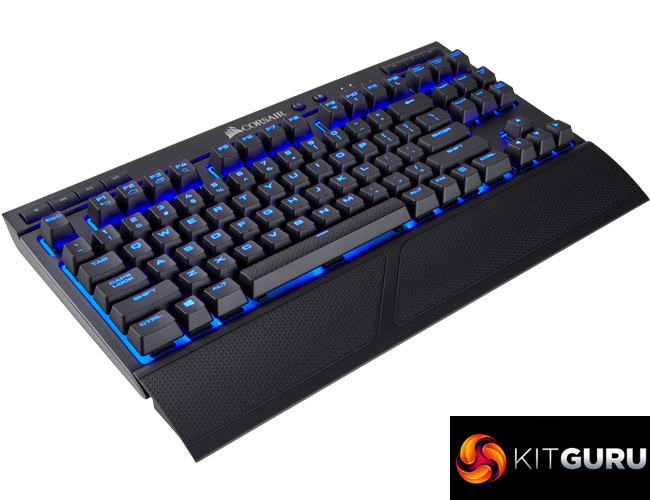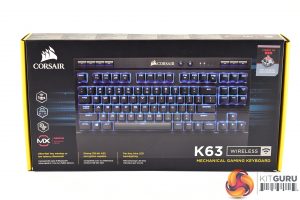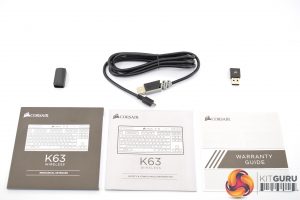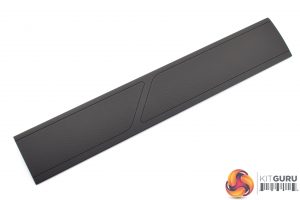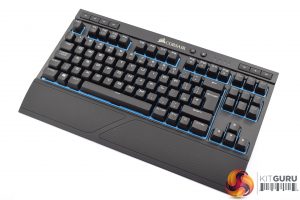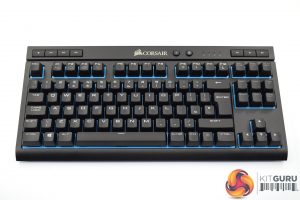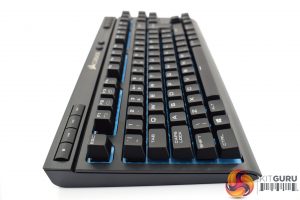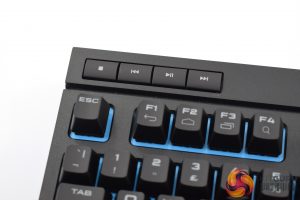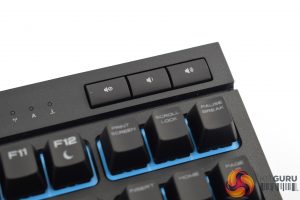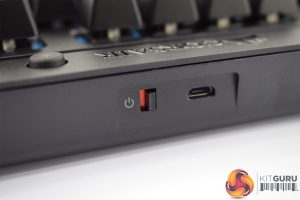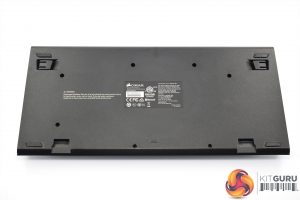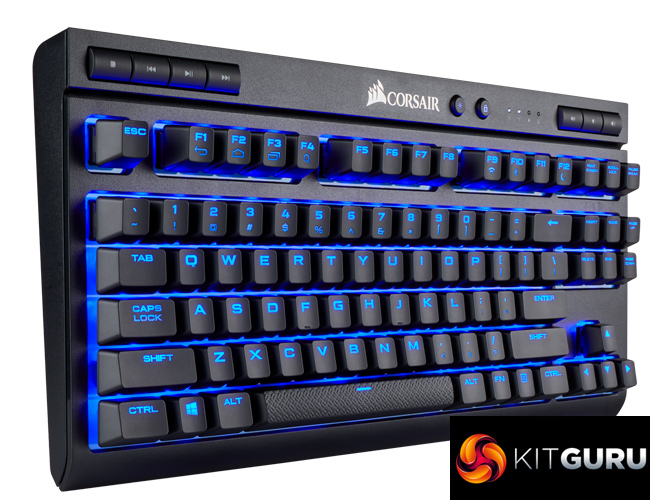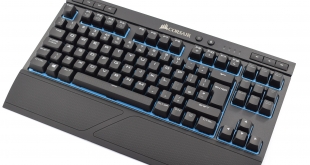
We're slowly starting to see wireless mechanical keyboards hit the mainstream, and to tap into this new trend Corsair has released its first wireless keyboard, aptly named the K63 Wireless. If you have ever used the original K63, the K63 Wireless is essentially the same thing but with the option for a wireless connection via a 2.4GHz dongle or over Bluetooth. At £119.99, does that make the K63 Wireless good value for money?
Despite the original K63 keyboard being one of Corsair's lower-tier options, it still boasts genuine Cherry MX switches, dedicated multimedia keys and an included wrist-rest. These features all carry over to the K63 Wireless as well, but now you have the option to connect the keyboard to your PC without using a cable. It's definitely convenient, but is it worth the extra outlay? Let's find out.
Specification
| Keyboard Model | K63 Wireless |
| Keyboard Backlighting | Blue LED |
| Matrix | 100% anti-ghosting with full key rollover |
| Media Keys | Dedicated (MUTE, VOL DOWN/UP, STOP, PREV, PLAY/PAUSE, NEXT) |
| WIN Lock | Yes |
| Dimensions | 366mm x 173mm x 41mm |
| Keyboard Size | Compact |
| Keyboard Layout | UK |
| Key Switches | Cherry® MX Red |
| CUE Software | Enabled |
| Wireless Connectivity | Ultra-fast 1ms 2.4GHz or Bluetooth® 4.2 + LE |
| Wired Connectivity | USB 3.0 or USB 3.1 Type-A |
| Battery Type | Built-in lithium-ion, rechargeable |
| Battery Charging | Charges via USB to computer |
| Battery Life | Up to 15 hours at normal brightness, 25 hours at low brightness, and 75 hours without backlighting |
| Wireless Encryption | 128-bit AES |
| Report Rate | 1000Hz |
| Wrist Rest | Full length with soft touch finish, detachable |
| Cable Type | 1.8 m / 6 ft, tangle-free rubber, detachable |
The Corsair K63 Wireless ships in a compact box, complete with Corsair's iconic yellow accents. A large photo of the keyboard itself is visible on the front – no wires in sight.
Inside, users are greeted by three small booklets – one quick-start guide, one warranty guide and one safety information guide. A 1.8m rubber cable is also included, as well as the 2.4GHz dongle and a microUSB to USB Type-A adapter. The adapter is to allow you to connect the 2.4GHz dongle to the charging cable to give you a bit more flexibility when positioning the dongle.
The other extra in the box is the detachable wrist rest which you can see above. It's really just a piece of plastic that connects to the keyboard via two small clips, though the surface of the wrist rest is textured, with a sort of soft-touch finish.
Coming to the keyboard itself, I think it is fair to say that the K63 Wireless looks like a fairly conventional mechanical keyboard. It is obviously quite compact as it makes use of the 80% (or tenkeyless) form-factor, with its dimensions listed as 366mm x 173mm x 41mm, but other than that it looks quite traditional.
As far as I can tell, it is made almost entirely from plastic. Being based on the K63 (non-wireless), one of Corsair's cheaper boards, we don't get the aluminium top-plate that is included with the likes of the K65 or the K70. Still, the board feels solid and has some heft to it thanks to its 1.09KG total weight.
There are, however, two sets of multimedia keys – one on the left-hand side and one on the right-hand set of the board.
On the left-hand side of the board we have play/pause, skip and stop functionality, while on the right-hand side there are volume up, volume down and mute buttons. They're simple additions, but I'd always rather have multimedia keys like this simply for the added convenience.
In terms of switches, the K63 Wireless uses Cherry MX Red mechanical switches. So far the keyboard is only available with MX Reds, though other variants may be released in the future.
You can also spot the blue base-plate which houses the Cherry switches. This is deliberately done to help the blue-only LED backlight ‘spread out' a bit more and create an underglow. We look at the lighting on the next page.
Moving over to the top edge of the board, here we find a simple power toggle alongside the microUSB connector. This is obviously how the keyboard charges, though it can also be used fully wired if you've run out of battery.
Lastly, turning to the underside of the board we find two height-adjustment stands in the top corners, while the two cut-outs at the bottom of the board allow the wrist rest to lock in place.To test the K63 Wireless I had it on my desk for one week. During this time, I used it as I would any other keyboard – by playing games and typing reviews – but with a particular focus on the wireless performance of the board.
Software
Starting with a look at the included software suite, the K63 Wireless uses the same Corsair Utility Engine (CUE) that we are now very familiar with.
Note: if the above gallery is not displaying properly, please disable your ad block software as they are known to interfere with our display code.
Being completely honest, there aren't too many options to play with in CUE. You can record macros in the usual fashion, the blue-only backlight has a few different effects that you can tinker with, while the performance tab allows you to adjust what Windows-based functionality the win-lock button disables.
That's it really – there's not a whole lot to adjust, but in fairness the K63 Wireless doesn't have as many advanced features as the likes of the K95 RGB Platinum do, so accordingly the software doesn't need to be as advanced.
Lighting
Given the backlight is blue-only – no RGB here – there's not a whole lot to comment on. Still, the lighting is even and looks good. You can also choose from a few different effects in CUE, including ‘rain', ‘wave' and ‘pulse' to name just three.
In terms of brightness, out of the box the K63 Wireless actually limits the LED brightness to 66%, purely to save on battery life. In daylight, this doesn't look too bright but it gets the job done, while at night-time it is more than bright enough for those late-night gaming sessions. You can manually override the 66% limit in CUE, but that will have a negative effect on the total battery life of the board.
Usage
In terms of using the keyboard day-to-day, we may as well talk about the wireless performance first as everything else follows from there.
In short, with the K63 Wireless connected to my PC via the 2.4GHz dongle, I honestly couldn't tell the difference between the wireless and wired modes. When connected over Bluetooth, however, there was a noticeable – if slight – delay between my typing and what would come up on screen, but it certainly wasn't unusable.
When using the 2.4GHz connection, I did notice that when the keyboard's battery was getting quite low, I would occasionally find a few keystrokes would be missed, but again that issue was not too common and if anything acted as a reminder for me to charge the battery. On the whole, though, the wireless performance is first class.
Now, that was just my personal experience with the K63 Wireless and the 2.4GHz connection. Corsair does say that using the 2.4GHz dongle has 1ms of latency, and that proved fast enough for me not to notice any delay. However, for those battle-hardened FPS veterans out there, maybe you could notice a slight delay when typing or gaming. For me, however, it was a complete non-issue.
With that out of the way, it's worth touching on the other aspects of the keyboard. I'll start with the build quality, something I briefly touched on on the previous page. Here, I don't think the K63 Wireless is quite on par with its more expensive siblings, primarily because it lacks the brushed aluminium top-plate we have seen on the likes of the K70 RGB or the K95 RGB Platinum. Accordingly, there is a touch more flex to the board, but nothing that is noticeable while typing.
In terms of the keyboard's design, I think the omission of that brushed aluminium top-plate – something which adds a more premium look and feel to other Corsair boards – does make the K63 Wireless seem a bit plain in comparison. Its not ugly, but its certainly not exciting to look at.
One thing that really frustrates me about the board's design is the small groove that runs the length of the board and sits just above the F-keys. As far as I can tell it serves no purpose at all, and it just collects dust and small bits of grit which are hard to clean out. Maybe its there just to add a bit of interest to the top of the keyboard, but I'd rather it was a fully flat surface.
The two sets of media keys, however, are excellent. The play/pause and skip buttons sit on the left-hand side of the board, putting them within easy reach of your left hand, while the volume and mute keys are on the right-hand side. They're very simple additions but once you get used to dedicated media keys, it's very hard to go back to using keyboards where the media keys are only secondary functions on the F-keys.
Now, another important aspect of any mechanical keyboard is the choice of switches. So far, the K63 Wireless is only available with Cherry MX Reds, though Corsair has suggested more options could be released if the interest is there. Reds aren't my personal favourite – I prefer Browns or Blues due to their tactile feedback – but we know many gamers love MX Reds due to their fast, linear action so that decision is understandable.
However, I did notice the switches on my keyboard exhibited a very noticeable amount of ‘ping‘ – an echoing noise after the switch's spring has been compressed. This affected almost every key on my sample, though some were worse than others. I'd hope this is just an early QC issue which can be ironed out, though I did speak to another reviewer whose sample also exhibited the same issue. This obviously may not bother you – in which case don't worry – but for me, I found the constant noise to be a bit irksome.
Lastly, the wrist rest is worth touching on. It's nothing special really, but I have always like the angle at which Corsair's wrist-rests slope down – it is just very comfortable for me. The surface of the wrist rest is textured and that helps with grip, however I did find the dimpled plastic would also pick up dust and little pieces of grit. All-in-all, it's just a piece of plastic but I found it to be comfortable and it's certainly something I'd rather have than forgo.
Battery life
Rounding off this part of the review, we finish with a mention of battery life. With the K63 Wireless, the blue backlight seems to be the determining factor as to how much battery life you get. According to Corsair, you can expect the following hours of usage depending on how bright you set the LEDs:
- 0% brightness – 75 hours
- 33% brightness – 25 hours
- 66% brightness – 15 hours
- 100% brightness – 10 hours
Now, to test the battery life I left all the brightness settings at their default settings – I touched absolutely nothing in CUE that was related to the backlight. That meant I had the brightness on 66% and the LEDs automatically turned off after 15 minutes of inactivity. I also turned the keyboard off when I went AFK for any prolonged periods of time.
With that in mind, I was quite impressed to see my sample last for 16.5 hours before the battery was completely drained and the keyboard turned off. That's 1.5 hours longer than Corsair's estimate, and it's certainly not bad at all. For me, 16.5 hours is just over 2 days of use, though I am sat at my desk most of the day due to my work.
Charging the keyboard back to 100% took just under four hours when plugged into a USB 3.0 port on the back of my motherboard. One thing to note is that if you have been using the keyboard in wired mode, the power toggle still has to be turned on as well – you can't just plug it in and expect it to power on, as other keyboards would do. That's not a real problem, except when it comes to turning your PC off. Here, if you forget to turn off the keyboard as well – even when it's been plugged in – it'll stay on and the battery will continue to drain.
I found this happened a few times when I'd been using the keyboard in wired mode – I'm just not in the habit of manually switching my peripherals off, as usually when my PC shuts down so do my peripherals. If you don't flick the power toggle on the K63 Wireless, however, you'll return to find an empty battery.Corsair's first wireless keyboard, the K63 Wireless is undoubtedly a solid piece of kit.
It keeps things simple with its design, though the tenkeyless (80%) form-factor may not be to everyone's liking. Still, the keyboard is well-built and the dedicated media keys are additions I think more keyboard manufacturers should be including.
I can't help but feel the keyboard is a bit plain, though, especially when you consider that it costs £120. It's obviously based on the original K63, which is one of Corsair's cheaper boards at £70, but for the extra outlay it would've been nice to see something new – a bit of metal, perhaps, to give it a more premium feel.
That aside, the K63 Wireless proved to be a very capable wireless mechanical keyboard. I had no issues with its 2.4GHz connection, and I can honestly say that latency was a total non-issue for me. Competitive gamers may notice the 1ms latency more than I did, but speaking for myself, the wireless connection was excellent.
Battery life is also solid, with my sample managing 16.5 hours at the default 66% brightness before giving up. That's actually 1.5 hours longer than Corsair's own battery life estimate, so overall I was pretty happy with it.
Other than that, the only other point to mention is that the switches on my sample did exhibit a fair amount of ‘ping' when the springs were compressed. We've passed this onto Corsair and hopefully it's just an early QC issue that can be ironed out.
So overall, I think the Corsair K63 Wireless is a proficient mechanical keyboard with an excellent wireless connection. I can't say anything about the board really blew me away, and you're obviously paying an extra £50-odd for the wireless functionality which won't be for everyone. However, if you are looking for a solid wireless mechanical keyboard, complete with Cherry MX switches, dedicated media keys and decent battery life, the K63 Wireless comes recommended.
You can buy one from Currys for £119.99 HERE.
Pros
- Excellent wireless connection using the 2.4GHz dongle.
- Good battery life at 66% brightness.
- Dedicated media keys.
- Well-built.
- Nice and compact.
Cons
- Design leaves a bit to be desired.
- My sample's switches exhibited a fair amount of ‘ping'.
- Groove at the top of the board collects dust and grit very easily.
KitGuru says: The K63 Wireless is undoubtedly a solid first wireless keyboard from Corsair. For £120 I'd have liked a slightly more interesting design, but the 2.4GHz connection is excellent for all you wireless gamers out there.
Be sure to check out our sponsors store EKWB here
 KitGuru KitGuru.net – Tech News | Hardware News | Hardware Reviews | IOS | Mobile | Gaming | Graphics Cards
KitGuru KitGuru.net – Tech News | Hardware News | Hardware Reviews | IOS | Mobile | Gaming | Graphics Cards


